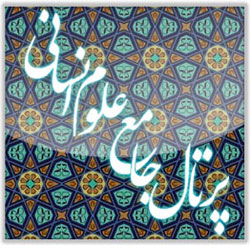بررسی برازش مؤلفههای معماری پایدار زیستمحیطی (سبز) در رونق اقامتگاههای بومگردی استان مازندران
کلمات کلیدی:
معماری پایدار, بومگردی, توسعه روستایی, تحلیل عاملی تأییدی, اقامتگاههای سبزچکیده
هدف این پژوهش بررسی برازش مؤلفههای معماری پایدار زیستمحیطی (سبز) در رونق اقامتگاههای بومگردی استان مازندران است. پژوهش حاضر به روش آمیخته و در دو بخش کیفی و کمی انجام شده است. در بخش کیفی با بهرهگیری از مصاحبههای نیمهساختاریافته با ۱۵ نفر از خبرگان حوزه معماری، گردشگری و مدیریت اقامتگاههای بومگردی، مؤلفههای اصلی معماری پایدار شناسایی و استخراج شدند. در ادامه، این مؤلفهها بهصورت کدگذاری شده وارد بخش کمی گردیدند. در بخش کمی، با توزیع ۲۱۳ پرسشنامه در میان گردشگران ساکن در اقامتگاههای بومگردی استان مازندران، دادههای مورد نظر گردآوری شد. دادهها با استفاده از تحلیل عاملی تأییدی (CFA) و نرمافزار AMOS مورد تجزیه و تحلیل قرار گرفتند. نتایج نشان داد که ساختار عاملی متشکل از هفت مؤلفه شامل توسعه کمی و کیفی محیطی، معماری بومی، دوستدار طبیعت، پایداری محیطی، عوامل اقتصادی، عوامل اجتماعی-فرهنگی و تحلیل هزینه-فایده، از برازش مطلوبی برخوردار است. تمامی شاخصهای برازش نظیر CFI، NFI، RMSEA و AGFI در محدوده قابل قبول قرار داشته و بیانگر همسویی سؤالات با سازههای مفهومی پژوهش هستند. همچنین بارهای عاملی برای تمامی گویهها بالاتر از 0.6 محاسبه گردید. نتایج پژوهش نشان میدهد که استفاده از مؤلفههای معماری پایدار در طراحی و مدیریت اقامتگاههای بومگردی میتواند منجر به ارتقاء شاخصهای زیستمحیطی، اقتصادی و فرهنگی در مناطق روستایی گردد. طراحی اقامتگاههایی منطبق با اصول پایداری، نهتنها تجربه گردشگری مسئولانه را ارتقاء میدهد، بلکه موجبات توسعه متوازن منطقهای را نیز فراهم میسازد.
دانلودها
مراجع
1. Azmat K, Shafi MM, Fahad S, Naushad M, Hanan F, Khan N. Effects of Eco-Tourism on Local Community in District Chitral Lower of Pakistan. J Asian Dev Studies. 2024;13(2):1201-12.
2. Üzümoğlu MD, Turkan Z. Architectural Characteristics of Accommodation Buildings Within the Context of Sustainable Ecotourism in Cyprus: Evaluation and Recommendations. Humanities and Social Sciences Communications. 2022;9(1).
3. Ananta BP, Eddy F, Abdillah W. A Lake Singkarak Resort Hotel. A Green Architecture Approach. Jurnal Koridor. 2022;13(02):1-9.
4. Chandran C, Bhattacharya P. Development and Implementation of Sustainability Criteria and Indicators for Eco-Lodges and Resorts in Ecotourism Destinations: Case Studies From India. Turizam. 2022;26(3):161-75.
5. Widayati CC, Malihah FD, Siregar A, Angeline W. Green Entreprenurship Based on Local Wisdom to Support the Attraction of Sustainable Ecotourism. Iccd. 2023;5(1):34-8.
6. Ridwan R, Zahrah Mr, Rahmawaty R. Ethnobotanical Study and Conservation Strategy of Medicinal Plants in the Ecotourism Area of Kedah Rainforest Lodges in Aceh, Indonesia. Biodiversitas Journal of Biological Diversity. 2023;23(12).
7. Azzahra PR, E NR, P IP, A NK, Khairiyah Y, Furqan A. Identifikasi Praktik Ecolodge Di Indonesia Berdasarkan Prinsip Ekowisata: Studi Literatur. Jurnal Nasional Pariwisata. 2023;13(1):52.
8. Liyushiana L, Sinaga JCH, Isma’il M, Denny A. Assessing the Spatial Aspects of Eco-Tourism Development in Bukit Lawang Area. International Journal of Sustainable Competitiveness on Tourism. 2023;2(01):36-43.
9. Aliwafa M, A SH, Kusumah FSF. Design and Build a Web Service for Mobile Ecotourism in the City of Bogor Using the Rest . Method. Jurnal Inovatif Inovasi Teknologi Informasi Dan Informatika. 2022;5(2):122.
10. Azis RMF, Islam D. Pengaruh Green Economy Dan Sustainable Ecotourism Terhadap Peningkatan Ekonomi Masyarakat Studi: Ekowisata Mangrove Lembung. El-Mal Jurnal Kajian Ekonomi & Bisnis Islam. 2024;5(12).
11. Malacapay MC, Tababa R. The Green Technology Practices and Investments of Sipalay City Beach-Resorts. Journal of Environmental Management and Tourism. 2020;11(7):1708.
12. Tlali LT, Musi ML. Gender Equality and Empowerment Through Corporate Social Responsibility in Ecotourism at Malealea, Lesotho: A Qualitative Study. Athens Journal of Tourism. 2021;8(4):247-68.
13. Yermolenko V, Zhuryna A. Peculiarities of Legal Regulation of Ecotourism in Poland: Prospects for Ukraine. Law Human Environment. 2021;12(3).
14. Wang XM, Mace E, Tao Y, Cruickshank A, Hunt C, Hammer G, et al. Large-Scale Genome-Wide Association Study Reveals That Drought-Induced Lodging in Grain Sorghum Is Associated With Plant Height and Traits Linked to Carbon Remobilisation. Theoretical and Applied Genetics. 2020;133(11):3201-15.
15. Zhao X, Yuan Y, Song M, Ding Y, Lin F, Liang D, et al. Use of Unmanned Aerial Vehicle Imagery and Deep Learning UNet to Extract Rice Lodging. Sensors. 2019;19(18):3859.
16. Chan JKL, Saikim FH. Exploring the Ecotourism Service Experience Framework Using the Dimensions of Motivation, Expectation and Ecotourism Experience. Tourism and Hospitality Research. 2021;22(4):425-43.
17. Singgalen YA. Sistem Pendukung Keputusan Pengembangan Ekowisata Mangrove Potensial Menggunakan Simple Additive Weighting (SAW). Journal of Computer System and Informatics (Josyc). 2023;4(3):478-85.
18. Bezuhla L. Ecotourism Development Trends in the Dnipropetrovsk Region. The Problems of Economy. 2020;3(45):94-103.
19. Shang Y, Bi C, Wei X, Jiang D, Taghizadeh‐Hesary F, Rasoulinezhad E. Eco-Tourism, Climate Change, and Environmental Policies: Empirical Evidence From Developing Economies. Humanities and Social Sciences Communications. 2023;10(1).
20. Wieckardt CE, Koot S, Karimasari N. Environmentality, Green Grabbing, and Neoliberal Conservation: The Ambiguous Role of Ecotourism in the Green Life Privatised Nature Reserve, Sumatra, Indonesia. Journal of Sustainable Tourism. 2020;30(11):2614-30.
21. Larsen F, Hopcraft JGC, Hanley N, Hongoa JR, Hynes S, Loibooki M, et al. Wildebeest Migration Drives Tourism Demand in the Serengeti. Biological Conservation. 2020;248:108688.
دانلود
چاپ شده
ارسال
بازنگری
پذیرش
شماره
نوع مقاله
مجوز
حق نشر 2025 نیکی امیری (نویسنده); سودابه مهری; عبدالله ابراهیمی (نویسنده)

این پروژه تحت مجوز بین المللی Creative Commons Attribution-NonCommercial 4.0 می باشد.









